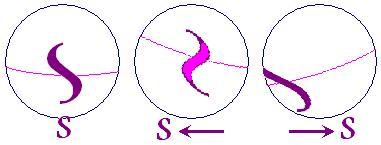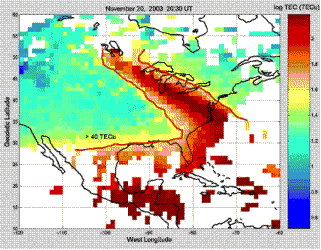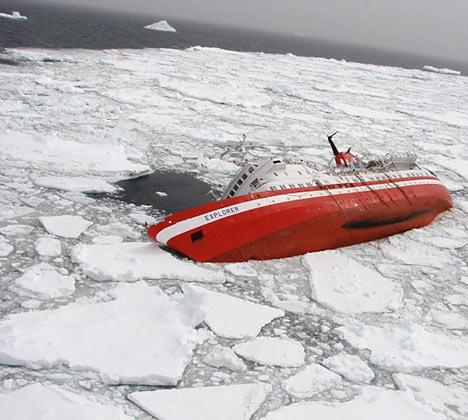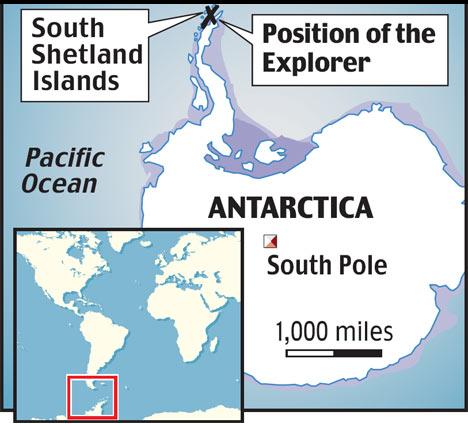Please do not reply to this Newsletter. You will likely get a response from a machine, not Nancy! For feedback on the
Newsletter or to correspond with Nancy, click here instead.
The Wobble Worsens
The Earth wobble first appeared in 2004, due to the close proximity of Planet X. The Zetas predicted at that time that this
would become much worse, and it has.
ZetaTalk Prediction 5/25/2004: Are we going to suddenly lurch about so that the Sun is rising and setting in a place
way off from where the public would expect? This is in your future, folks, but we will not give you the date.
At that time, in early 2004, the wobble involved a grab of the highly magnetized Atlantic Rift, which caused the Earth to tilt
slightly from side to side during the daily rotation.

The wobble then evolved to a "drunken lurch" as the N Pole of Earth began being pushed away. This push was violent, and
thus the wobble became more violent - like a drunken lurch.
ZetaTalk Explanation 11/27/2004: As the Earth normally rotates around its geographic N. Pole, the magnetic N.
Pole is exposed for half the day, and then hidden for the other half of the day. This initially results in a drunken
lurch to push the magnetic N. Pole out of view.
The drunken lurch was depicted on weather maps captured on the same day in November, 2004. Note the odd warm spot
(pink) over Hudson Bay, and the odd cold spot (pea green) inland in Siberia. These spots are on opposite sides of the N
Pole from each other, showing how the drunken lurch caused the sunlight to linger over Hudson Bay and thus be absent
from Siberia during that same time period.

The drunken lurch then evolved in 2005 into a figure 8, which has persisted to the present date. The wobble today is caused
by the N Pole of Earth being pushed away, on a daily basis, by the hose of magnetic particles coming from the N Pole of
Planet X. This is similar to the drunken lurch but rolls around in a figure 8 instead of merely going back and forth.

ZetaTalk Explanation 11/27/2004: This is due to the magnetic N Pole being either to the right or left of the
geographic N Pole as the globe turns, responding to the emerging hose of magnetic particles from the N Pole of
Planet X as it turns about, in place. As Europe is emerging into dawn, the European tilt is created where the Sun
seems to be too far to the NW. For dawn in the Americas, a tip away of the Earth's magnetic N Pole creates the
Americas' tilt, where the Sun seems to be too far to the SW. As the globe turns and the magnetic N Pole of Earth
escapes out of view, this tilt is relaxed to assume a simple severe tilt of both the magnetic and geographic N. Poles
of the Earth away from Planet X, giving the Pacific tilt, where the Sun is simply too far to the South. Moving to the
last quarter of the day, when the magnetic N Pole of Earth is hidden, the Earth can assume a more normal posture,
the India posture.
In November 2007, the wobble increased, just as the Zetas had predicted in 2004 and just as the Zetas had been warning
during the summer of 2007. Where in 2005 the data collected indicated the tilt during the figure 8 wobble ranged between
4-21°, the 2007 wobble data indicated this had increased to range between 19-38°. Almost double.
The morning at 8:15 am on November 15 in Madrid the Sun was at some 115 º E. (Skymap expects it to be at 116°,
so very close.) I managed to make my measurement this evening too at 5:45 pm. The Sun was at some 275 º
(Skymap expects it to be at 244°, 31° too far to the North.)
[and from another]
Last week I shot an azimuth of the sun at sunset. It was 242-244°. The table said it should have been 262° at my
location. Checked the azimuth for the Solstice. 248°. That is further south than the solstice's furthest point On
December 21.
[and from another]
For Santiago city on November 19 at 12:27 daylight time in Chile, Stellarium expects Azi 48° Alt 70°. Well , I seem
to have observed Azi 10° Alt 82°. On November 20 at 11:26 have again taken a look at our current Sun position,
against Stellarium. Stellarium expects Azi 71° Alt 60°. I seem to have observed Azi 45° Alt 75°. Again, the Sun
seems to be higher and displaced to the West.
Magnetic swings were noted as the day progressed, showing the stress being placed upon the N Pole of Earth.
On November 11 at 7:56 am my compasses in Pennsylvania read 30° West of North. They had moved even more
West than days before. Then at 2:19 pm in the afternoon I checked the compasses and the move was now about 58°
West of North. I've never seen it go this far before.
On November 15, 2007 a dramatic double global quake occurred, almost exactly 12 hours apart. This signature often
occurred in 2004 when the Atlantic Rift was tugged twice daily, but this double global quake in 2007 did not line up with the
Atlantic Rift tug.
Quakes on November 15 were a Magnitude 6.2 at 15:03 UTC and a Magnitude 6.8 in the afternoon at 15:06 UTC
on the coast of Northern Chile. Quakes on November 16 were a 6.3 Magnitude at 3:12 UTC and a Magnitude 6.7
at 3:13 UTC in or near Ecuador.

The Zetas had an explanation for all these phenomena.
ZetaTalk Explanation 11/17/2007: The wobble has become more extreme, as evidenced by reports Nancy has
received lately.
- The major quake clusters on November 16, accompanied by a global shudder, happened almost exactly 12
hours apart, at 3:12 UTC and 15:03 UTC. This is caused by the wobble, which forms a figure 8, and has
lately become more extreme. As the Earth rotates the N Pole of Earth is pushed away from Planet X when it
comes into view. This is when it is pre-dawn in Alaska. And then the Earth bounces back into its normal
position when the N Pole of Earth disappears over the horizon again at dusk over Alaska. At 3:12 UTC the
Sun stands high overhead over the mid-Atlantic and Alaska is approaching her dawn. Exactly 12 hours later
the Sun stands high overhead over Korea and Alaska is seeing her sunset.
- This stress on the N Pole of the Earth registers on compasses also, as one observer in Pennsylvania noted
that the N Pole seemed to be pushed further west as the day progressed. Why would this be? In the early
morning in Pennsylvania, the N Pole above Alaska has yet to be exposed to the magnetic pressure from the N
Pole of Planet X, which is increasingly pointing toward Earth. In the early afternoon in Pennsylvania, Alaska
is almost fully exposed, with the magnetic fields of Earth attempting to bow and mold to escape the pressure
of magnetic particles from the N Pole of Planet X.
- The figure 8 wobble affects Europe by putting the sunrise in more or less the correct position, as the Sun is
over India at that time and there is no tilt to the geographic pole of Earth at that time. But as Europe
approaches sunset, there is a tilt of the geographic pole, with the N Pole leaning away to the left, from the
perspective of Europe relative to the Sun, so the Sun appears too far North during sunset. These
measurements from Europe are more extreme than in the past as the wobble has become stronger per our
predictions.
- When the Earth rotates so the Sun is over North America the tilt of the geographic pole switches to lean to
the right, from the perspective of North America relative to the Sun, so the Sun appears too far south at
mid-day and this lingers into the evening. It is not until well after sundown in N America that the geographic
pole straightens up, when the Sun is centered over Asia. These measurements from North America are more
extreme than in the past as the wobble has become stronger per our predictions.
Ion-Plume
The Zetas state that Planet X arrived in the inner solar system in 2003. It approached the Sun rapidly and then put on the
brakes due to the repulsion force that exists between large planetary bodies, not hitting the Sun but creeping past the Sun
slowly. Today it has crept past the Sun and is starting its outbound sling away from the Sun. The large charged tail of Planet
X trailed behind it as it plunged toward the Sun in 2003, but when it put on the brakes to avoid hitting the Sun, the tail did
not halt but wafted PAST the Sun toward Earth. It was late summer of 2003 when the Earth experienced many odd
electrical disturbances worldwide - blackouts and brownouts due to electrical surge on the grid. A fine red dust was noticed
also at that time, being deposited on patio furniture and car hoods. The tail today has returned to waft the Earth, with a
reappearance of the fine red dust and, it appears, electromagnetic disturbances in the atmosphere of Earth.
- Strange Space Weather over Africa
November 12, 2007
http://www.physorg.com/news114186174.html
- Something strange is happening in the atmosphere above Africa and researchers have converged on Addis
Ababa, Ethiopia, to discuss the phenomenon. The strange phenomenon that brings all these people together is
the ion plume-a newly discovered form of space weather. Ion plumes are made of electrified gas floating so
high above ground they come in contact with space itself. The plumes appear during geomagnetic storms and
they can interfere with satellite transmissions, airline navigation and radio communications. It is their effect
on GPS signals that led to the discovery of plumes over North America just a few years ago. A typical
example is the plume of November 20, 2003. Two days before this map was made, an explosion on the sun
had hurled a cloud of magnetized gas-a CME-toward Earth. The plume formed when the CME hit, triggering
a strong geomagnetic storm.

Scientists are blaming these atmospheric plumes on the Sun, but the Zetas have a different explanation. GPS satellites, after
all, have been around for decades. Why are these satellites only being troubled by the plumes since 2003?
ZetaTalk Explanation 11/17/2007: We have consistently described the tail of Planet X as a "charged" tail. During
the passage, lightning passes between the Earth and Planet X due to the nature of this tail, as we have described
within the body of existing ZetaTalk. If this lightning were to pass from Planet X toward Earth, it would be
devastating to Earth, but it moves in the opposite direction. Planet X is almost entirely a water planet, and absorbs
these strikes in its vast oceans. It is the charged nature of the dust cloud that causes it to cling to Planet X, creating
a shroud around it so it cannot easily be seen from afar. Unless sunlight is bouncing off this shrouding dust cloud so
that it can be seen it appears as a dim fuzzball. The moons of Planet X and large debris in its tail are held in place
by the gravitational attraction of Planet X, but the dust particles, which are ionized iron in the main, are held in
place by their charged nature. Planet X is a large magnet, as we have explained since the start of ZetaTalk. Why
has NOAA just taken such an interest in this new phenomena - the ion plumes? It is because they interfere with GPS
satellites, and the functioning of other satellites. As Planet X comes closer toward Earth the licks of its tail are more
serious because the tail is more dense the closer the Earth gets to Planet X. NOAA and other government agencies
know that problems with satellites will become exponential, with the repercussions huge. They are trying to prepare
for this day by at a minimum learning how fast the phenomena is increasing.
Predatory Icebergs
On Thanksgiving day, a cruise ship and an iceberg had an encounter off the coast of Antartica, sinking the ship. Titanic
redux! Where icebergs causing ships to sink is not a new occurrence, the MS Explorer was built to withstand such
encounters.
- Cruise ship goes down off Antarctica
November 23, 2007
http://www.msnbc.msn.com/id/21935099/
- A Canadian cruise ship struck submerged ice off Antarctica and began sinking, but all 154 passengers and
crew, Americans and Britons among them, took to lifeboats and were plucked to safety by a passing cruise
ship. The Chilean navy said the entire MS Explorer finally slipped beneath the waves Friday evening, about
20 hours after the predawn accident near Antarctica's South Shetland Islands. No injuries were reported
although passengers reportedly endured subfreezing temperatures for several hours as they waited in bobbing
lifeboats for a Norwegian liner that took them to a Chilean military base in the region. The Explorer struck
submerged ice and began taking on water through its cracked hull.

Whereas icebergs causing ships to sink is not a new occurrence, the MS Explorer was built to withstand such encounters.
What went wrong?
ZetaTalk Comment 11/24/2007: The anticipated speed of ocean currents guide ship captains when they enter ice
fields. Encounters have two vectors to consider - the movement and speed of the ship, and the movement and speed
of any icebergs in the area. Clearly icebergs were anticipated. Clearly the ship captain was aware of his ship's
speed. What he did not anticipate was the movement and speed of the iceberg. We warned that ocean whirlpools
would develop, not seen in the memory of man and only alluded to in folklore. These have been appearing, most
notably off the coast of Australia. We warned of storm clash, creating huge waves, and these have been on the
increase too. The base cause of these changes in ocean tides is the Earth wobble which developed as a result of the
close proximity of Planet X to Earth. We warned that ocean tides would become erratic as this Earth wobble
developed, pulling the waters along with the lurching Earth to disrupt the normal and anticipated tides. Does the
location of the MS Explorer accident have any bearing on why erratic tides were encountered? It does indeed, as
land's end at the tip of a peninsula is equalizing water pressure on either side of the peninsula, and in the case of the
Antarctic peninsula is equalizing pressure in the Atlantic with pressure in the Pacific. There was a rush of water,
bearing icebergs, which in this case became predatory icebergs. Such incidences will be on the increase.

Indeed, the Zetas had predicted the ocean wobbles.
ZetaTalk Prediction 4/15/1999: The oceans will continue, as will the weather, the ocean of air, to become more
erratic. Warm oceans will occur in places where they should be cool.
ZetaTalk Prediction 2/18/2005: We have defined weather wobbles as atypical wind storms resulting from sudden
movement of the crust under the atmosphere during the polar wobble, but ocean currents are also affected, rushing
first one way and then the next.
Video Clip on the Visitors
 The Zeta Report 15 - The Visitors. Do they look like humans or are they really weird? When preparing
for contact, expect almost anything. Click on the image or click Here to watch. The Zeta Report 15 - The Visitors. Do they look like humans or are they really weird? When preparing
for contact, expect almost anything. Click on the image or click Here to watch.
You received this Newsletter because you subscribed to the ZetaTalk Newsletter service. If undesired, you can quickly Unsubscribe.
|

